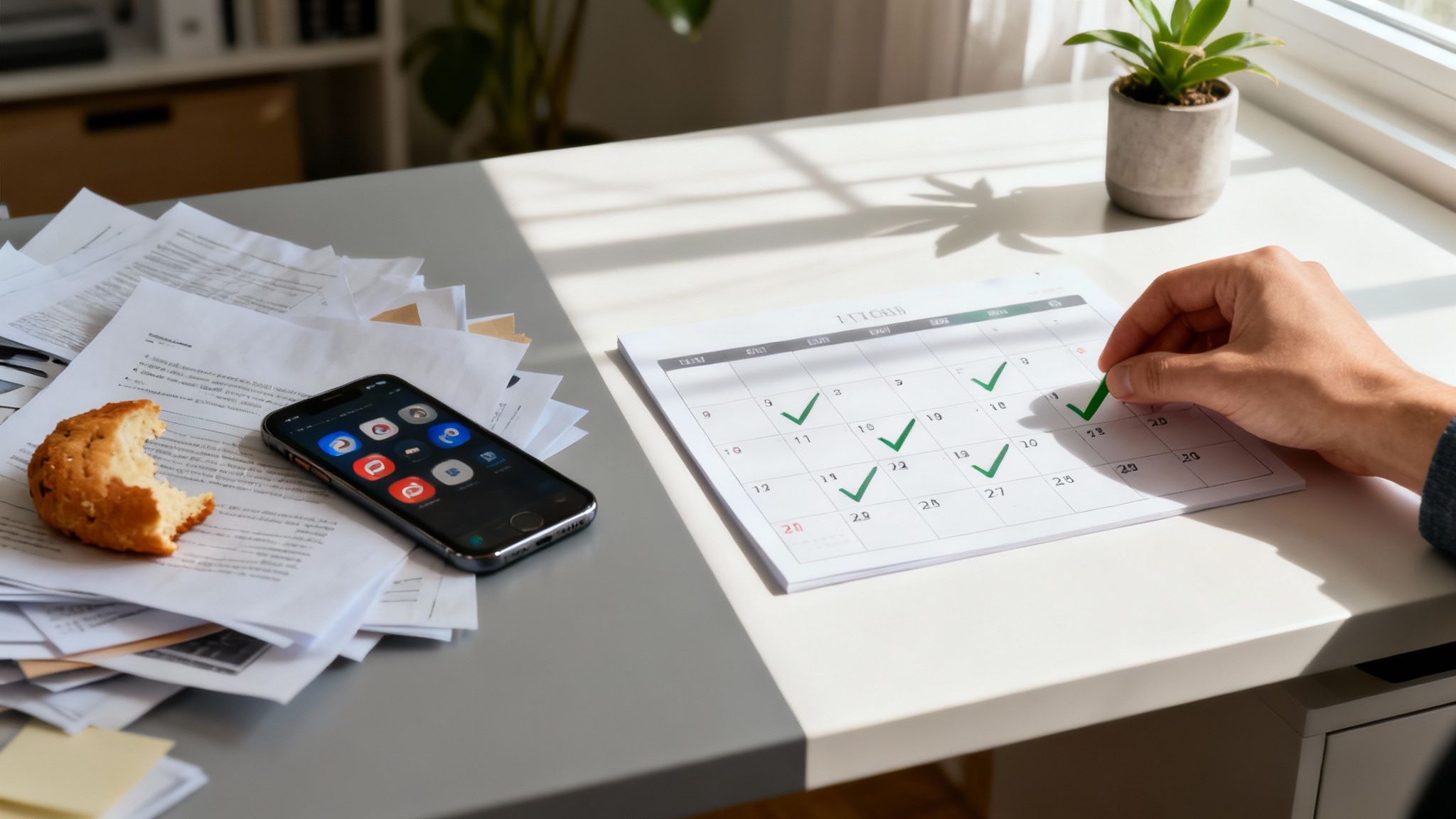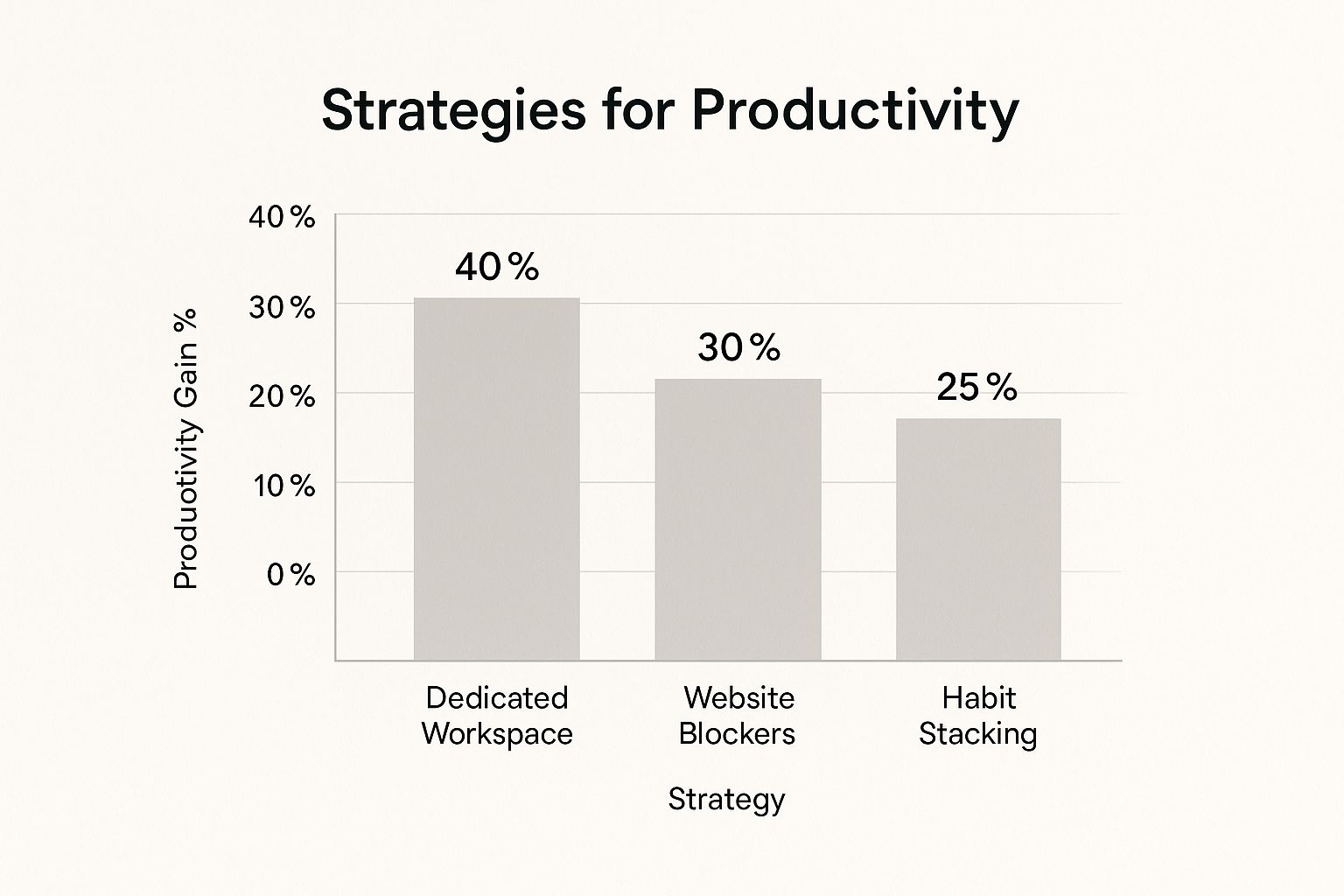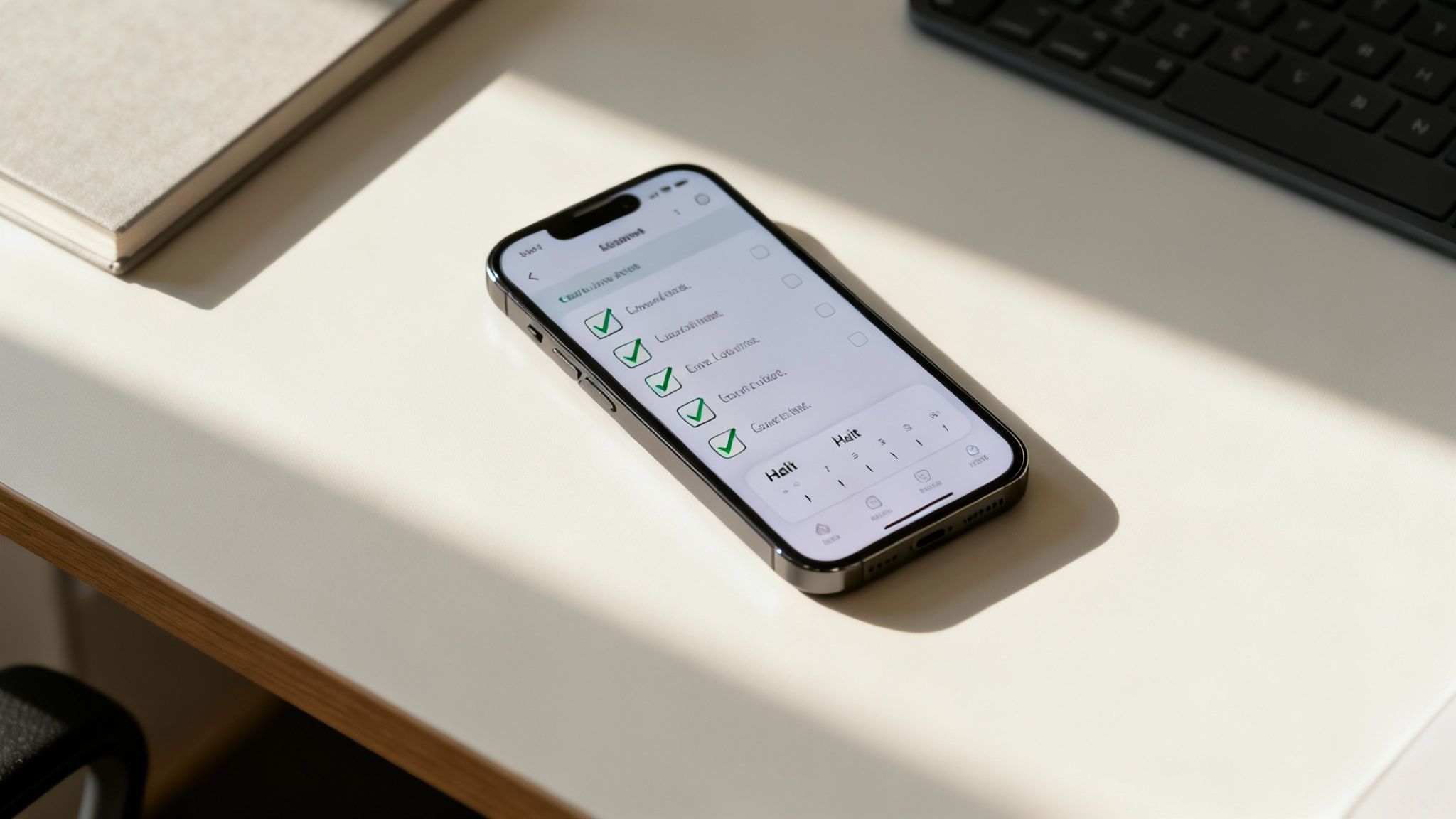How Can You Stop Procrastinating? Top Strategies Today

How Can You Stop Procrastinating? Top Strategies Today
If you want to finally stop procrastinating, you need a crucial mindset shift. Procrastination isn't a character flaw or a sign of laziness. At its core, it’s an emotional reaction. The secret is to stop trying to force yourself to work and start addressing the negative feelings—like anxiety, boredom, or self-doubt—that are tied to the task itself. This is the real first step to breaking the cycle for good.
Why You Really Procrastinate (Hint: It’s Not Laziness)

Let's get one thing straight right away: procrastination has nothing to do with being lazy. If you were truly lazy, you wouldn’t be plagued by the guilt, stress, and anxiety that always seem to accompany putting things off. The truth is much more interesting. Procrastination is actually a form of emotional regulation.
Think about the last thing you put off. Was it a complicated report for work? A difficult conversation you needed to have? Maybe it was just cleaning out that messy garage. You weren't avoiding the task; you were avoiding the feelings the task brought up.
The Emotional Triggers of Avoidance
Our brains are fundamentally wired to seek out pleasure and run from pain. When a task triggers negative emotions, our knee-jerk reaction is to escape. This gives us a moment of relief, but it kicks off a vicious cycle where the task just gets bigger and the stress gets worse.
What are these triggers? They usually fall into a few common buckets:
- Anxiety or Fear: This is a big one. You might worry about failing, not living up to expectations, or facing criticism. Pushing the project off feels safer than confronting potential negative feedback.
- Boredom or Lack of Interest: If a task is just plain dull, your brain will naturally start looking for a quick hit of something more stimulating. Hello, social media rabbit hole.
- Frustration or Confusion: When you don't even know where to begin, the mental energy it takes to get started can feel massive. Avoidance becomes the path of least resistance.
- Perfectionism: The need to do something perfectly can be absolutely paralyzing. If the standard you've set feels impossibly high, it’s often easier to just not start at all.
Once you start recognizing these triggers in yourself, you can finally tackle the root cause. The problem isn't your work ethic—it's your emotional response to the work.
The real insight here is that procrastination is simply a strategy for dealing with difficult emotions. You're not lazy for avoiding something that feels bad; you're human. The goal is to find a healthier, more effective strategy to manage those feelings.
From Vague Plans to Last-Minute Panic
This emotional avoidance creates what researchers call an "intention-action gap"—the chasm between what we intend to do and what we actually do. This gap is widest for tasks with far-off deadlines, which makes it easy to put them off without any immediate pain.
Procrastination isn't just a personal failing; it's a well-documented behavioral pattern. Studies consistently show that most of us plan to get work done but end up delaying, especially when the due date is weeks away. You can dive deeper into these findings and check out the procrastination statistics on Zipdo.
As the deadline gets closer, the "deadline effect" kicks in, forcing a last-minute scramble. This frantic rush might get the task done, but it's a costly way to work. It leads to higher stress, lower-quality results, and reinforces the dangerous myth that you only perform well under pressure.
Shifting Your Perspective for Good
Learning how to stop procrastinating starts with changing your internal monologue. Instead of beating yourself up for being "lazy" or "undisciplined," try practicing a little self-compassion.
Next time you feel the urge to put something off, pause and ask yourself:
- What feeling am I trying to dodge right now?
- Is it fear of failure? Boredom? Overwhelm?
- What is the absolute smallest step I can take to move forward?
This kind of self-awareness is your most powerful weapon. It reframes the struggle from a battle of willpower versus laziness into a strategic act of managing your emotions with kindness. By pinpointing the underlying feeling, you can finally start building healthier coping skills that don't rely on avoidance. This is the foundational shift that puts you back in control.
Adopt These Mindsets To Take Action Now

Realizing that procrastination is often an emotional issue is a huge first step. The next, and arguably most important, is to actively reframe how you think about the tasks you’re avoiding. Lasting change in your behavior is nearly impossible until you get your head in the right space. These aren't just fluffy "positive thinking" exercises; they are practical mental tools I’ve seen work time and again to lower the barrier to getting started.
Forget about making some grand resolution to "be more productive." That's a setup for failure. Instead, let's focus on a few small, strategic shifts that can trick your brain into just starting. The goal isn’t to magically eliminate those feelings of dread but to make the first step so ridiculously easy that you do it anyway.
Master the Two-Minute Rule
One of the most powerful tricks I know for snapping out of procrastination is to shrink the task until it’s almost laughable. This is the whole idea behind the Two-Minute Rule, a brilliant technique from author James Clear. The rule is simple: any task or new habit must take less than two minutes to begin.
So, "write the report" becomes "open the document and write one sentence." "Clean the entire kitchen" turns into "put one dish in the dishwasher."
Why on earth does this work? It completely sidesteps that feeling of being overwhelmed that sends you running for a distraction. Committing to just two minutes feels like nothing, but once you start, momentum often takes over. The hardest part of any task is getting off the starting block.
Break It Down with Task Chunking
Okay, but what about those giant, intimidating projects where the Two-Minute Rule feels like a drop in the ocean? That’s where task chunking comes into play. A massive goal like "launch a new website" or "prepare a major presentation" is practically a formal invitation for procrastination. It's too big, too vague, and frankly, too scary.
Task chunking is just what it sounds like: breaking that monster project down into a list of small, concrete, and non-threatening steps. Think of it like building a LEGO set. You don't try to build the whole castle at once—you just connect one little brick to another.
Let's take "prepare a major presentation." You could break it down like this:
- Brainstorm three main talking points.
- Find one compelling statistic for the intro.
- Create a blank slide deck with just a title slide.
- Write a rough outline for only the first section.
- Find one good image for the title slide.
Each of those is a clear, doable action. Ticking them off your list provides a little hit of dopamine that builds positive momentum, directly fighting the negative feelings that made you avoid the project in the first place.
The secret to overcoming procrastination isn't finding a sudden burst of motivation. It's about lowering the activation energy required to start. Your only job is to focus on the immediate next step, not the entire staircase.
This mental shift is everything. You change your internal script from "I have to finish this entire presentation" to "All I have to do right now is find one good image." That simple change evaporates the pressure and makes it so much easier to begin.
Embrace Self-Compassion Over Guilt
This might sound backward, but one of the absolute worst things you can do after procrastinating is to beat yourself up. That cycle of guilt and self-criticism is a toxic fuel for more procrastination. When you start associating a task with feelings of shame and failure, you're practically guaranteeing you'll avoid it again.
Research has actually shown that self-compassion is a much better motivator than self-criticism. It’s about treating yourself with the same kindness you'd give a friend who's having a hard time.
Instead of thinking, "I'm so lazy, I wasted the whole day," try this instead:
- Acknowledge the Feeling: "I feel anxious about this project, and that's why I put it off."
- Recognize Common Humanity: "Lots of people struggle with this. It's a totally normal reaction."
- Offer Kindness: "It's okay. What's one small, kind thing I can do for myself to get back on track?"
This approach short-circuits the shame spiral. It separates what you did from who you are—you aren't a procrastinator; you just procrastinated. The distinction is subtle but incredibly powerful, allowing you to move on without the baggage of self-judgment.
Design An Environment That Defeats Procrastination
Changing your mindset is a huge part of the puzzle, but even the best intentions can get steamrolled by a distracting environment. If your surroundings are actively working against you, you're fighting an uphill battle you’re almost guaranteed to lose. The trick is to stop relying on raw willpower and start building a physical and digital world where focus is the easy choice.
Think of your environment as the collection of cues and obstacles in your daily life. The goal is to deliberately make your distracting habits harder to do while making your productive habits feel effortless. You want to make checking social media feel like a chore and getting started on your real work feel like the most natural thing to do.
Engineer Your Physical Space for Focus
Your brain is constantly scanning your surroundings for clues on what to do next. When your workspace is also your "chill-out" space, your brain gets mixed signals. That’s why setting up a dedicated spot just for deep work is one of the most powerful things you can do to signal, "Okay, it's time to get serious."
This doesn't mean you need a fancy home office. It could be a specific corner of your bedroom or even just the left side of the dining table. The rule is simple: when you're in that spot, you only do focused work. No scrolling Instagram, no snacking, no watching YouTube. Over time, your brain forges a powerful link between that physical location and a state of productivity.
Take it a step further by prepping your space the night before. If you need to write a report tomorrow, leave the document open on your computer. Planning a morning workout? Lay out your gym clothes. By smoothing out these tiny points of friction, you make it so much easier to get started when the time comes.
Create Digital Guardrails
Let's be honest: our digital world is engineered to distract us. Notifications, infinite scrolls, and autoplay videos are all designed to grab your attention and not let go. The only way to win this game is to consciously build up your defenses.
This goes way beyond just turning off notifications. You need to actively use tools that create a real barrier between you and your biggest time-wasters. Browser extensions and apps that block certain websites during your scheduled work hours aren't a sign of weakness; they're a sign of being strategic.
Here are a few practical ways to build that digital friction:
- Use Website Blockers: Tools like Freedom or Cold Turkey can block distracting sites during your "focus blocks." Schedule them in advance.
- Log Out of Social Media: The tiny hassle of having to enter your password can be just enough of a pause to make you question if you really need to be scrolling right now.
- Curate Your Home Screen: Banish distracting apps from your phone's home screen. Shove them into a folder on the second or third page and replace them with tools that actually help you.
This infographic shows just how much of a difference a few of these environmental tweaks can make.

As you can see, simply creating a dedicated workspace has the biggest impact, which really drives home how powerful physical cues are for our brains.
Integrate New Habits Seamlessly
Another fantastic way to shape your environment is by redesigning your routines. One of my favorite techniques for this is called habit stacking. The idea is to piggyback a new, desired habit onto a behavior you already do automatically. You’re basically using the momentum of an existing routine to pull the new one along for the ride.
So, instead of trying to conjure up the motivation to do something new out of the blue, you link it to a trigger that already exists. For example, you could stack the habit of planning your day onto your morning coffee ritual.
Your new habit chain might look like this: After I pour my morning coffee (existing habit), I will immediately sit down and write my top three priorities for the day (new habit).
This works so well because it weaves the new action into a part of your day that requires zero thought. It starts to feel less like a chore and more like part of the natural flow.
It's a simple way to combat procrastination on the small planning tasks that make a huge difference. A shocking 82% of people don't use any kind of formal time management system, leaving them wide open to distraction. And with the average person losing nearly three hours a day to social media, we need all the help we can get. For a deeper dive, check out these insightful time management statistics from Clockify.
Ultimately, by designing your environment and routines this way, doing the right thing eventually becomes the path of least resistance.
Find The Right Tools To Support Your Goals

Trying to overcome procrastination with willpower alone is a losing battle. It’s like trying to build a house with your bare hands—you might make some progress through sheer force, but you'll burn out fast. Here's a secret: productive people don't necessarily have more willpower. They just build better systems that make doing the work feel easier than avoiding it.
When you bring the right tools and techniques into the mix, you're essentially outsourcing your discipline. This frees up precious mental energy for the task itself, rather than spending it fighting the urge to do something else. You're creating a framework that pulls you forward, even on the days you don't feel like it.
Choose Your Tools Wisely
We're swimming in a sea of productivity apps, but grabbing the shiniest new one isn't the answer. In fact, endlessly trying new apps can become its own form of procrastination. The real key is to find a tool that solves the specific problem that’s tripping you up.
So, get honest about what triggers your avoidance.
- Feeling completely overwhelmed? A visual project management tool like Trello or Asana can be a game-changer. They let you break massive projects into small, visible chunks, making the whole thing feel far less terrifying.
- Constantly forgetting small tasks? Don't let those little things occupy your headspace. A simple to-do list app like Todoist or even your phone’s built-in reminders can take that mental load off your plate.
- Just can’t build momentum? A great habit tracker is your best friend here. This is where a platform like Soberly comes in, not just for sobriety but for locking in any positive routine. Every time you check off a task, your brain gets a tiny hit of dopamine.
That little dopamine reward is more powerful than you think. It directly counteracts the dread and anxiety that fuel procrastination, creating a positive feedback loop that actually makes you want to keep going.
Your tools should serve you, not the other way around. The best system is the one you will actually stick with, whether it's a sophisticated app or a simple pen-and-paper notebook. The goal is consistency, not complexity.
Match Your Method to Your Work Style
Beyond apps, finding the right time management philosophy can give you the structure you need to finally stop putting things off. What works for a freelance designer who thrives on creative bursts is going to be totally different from what works for a detail-oriented project manager. It’s all about understanding your natural rhythm.
Take the Pomodoro Technique, for instance. It’s built on working in focused 25-minute sprints and is brilliant for people who get distracted easily. It makes starting a dreaded task feel incredibly low-stakes—after all, you can do anything for just 25 minutes. On the other hand, someone who needs long, uninterrupted blocks of "deep work" would find the constant breaks maddening.
To help you find a good fit, let’s look at a few popular techniques and how they specifically target procrastination.
Choosing Your Time Management Technique
Finding the right system is a personal journey. This table breaks down some of the most effective methods to help you pinpoint an approach that aligns with your personality and tackles your specific procrastination triggers.
| Technique | Best For | How It Fights Procrastination |
|---|---|---|
| The Pomodoro Technique | Those who get easily distracted or overwhelmed by long tasks. | By breaking work into short, 25-minute intervals, it lowers the mental barrier to starting. The finish line is always just a few minutes away. |
| Time Blocking | People who need structure and want to proactively schedule their priorities. | It assigns a specific job to every hour of your day, eliminating the indecision that often leads to putting things off. You know exactly what you should be doing. |
| Eat the Frog | Individuals who tend to put off their most important or difficult tasks. | This method forces you to tackle your biggest, most dreaded task first thing in the morning, creating a massive sense of accomplishment that fuels the rest of your day. |
| The Ivy Lee Method | Those who feel scattered and struggle to prioritize effectively. | By forcing you to identify just six key tasks for the next day, it eliminates overwhelm and provides a clear, actionable plan before you even begin your workday. |
The best way forward is to experiment. Pick one of these methods and give it a real shot for a week. See how it feels. Does it make you less stressed or more? The goal isn’t to find a perfect, rigid system, but to discover a flexible framework that makes your work feel manageable. That’s how you build a lasting defense against procrastination.
How to Recover From Setbacks and Stay Motivated
Let’s get real for a second. The road to beating procrastination is never a straight line. You're going to have days where you slip back into old habits, where the siren call of your favorite distraction is just too strong to resist. That's okay. The real test isn't about being perfect; it's about how you bounce back.
Think of a setback less like a failure and more like a piece of data. Every time you slip up, you learn something new about your own triggers and weak spots. The trick is to get back on your feet quickly, armed with that new insight, without letting guilt or shame drag you down.
Conduct a "Procrastination Post-Mortem"
So, you just spent two hours scrolling on your phone instead of working on that big project. The natural reaction is to beat yourself up. Don't. Instead, get curious. Do a quick, judgment-free "post-mortem" to figure out what actually happened. This isn't about blame; it's about spotting patterns so you can outsmart your future self.
Ask yourself a few direct questions:
- What was the trigger? Was it a specific feeling like stress or boredom? Maybe you were just tired.
- What was the exact distraction? Did you fall down a YouTube rabbit hole, or did you start "productively procrastinating" by cleaning out your inbox?
- When did it happen? You might notice a pattern, like your focus always tanks mid-afternoon.
- What feeling were you trying to avoid? Get honest. Was it the fear of not doing a good enough job? The sheer overwhelm of the task?
The answers are your roadmap. If you always crash and burn at 3 PM, maybe that's the perfect time to schedule a walk. If you realize big projects make you anxious, you know that breaking them down is non-negotiable next time.
Build in Accountability and Pre-Commitment
Trying to fight procrastination all on your own is tough. One of the best things you can do is bring in some outside accountability. It can be as simple as telling a friend, "Hey, I'm planning to finish this report by Friday." Just saying it out loud makes it more real and adds a little positive social pressure.
For times you know will be challenging—like a crazy week at work—try using pre-commitment. This just means making a decision for your future self right now, while you're still feeling clear-headed. You could block out "deep work" time on your calendar and ask a coworker to check in on you, or use an app to block distracting websites before the temptation even starts.
You're not just "trying harder." You're building a system that makes it easier to do the right thing, especially when your willpower is running on empty. This shift from relying on motivation to relying on structure is everything.
Celebrate the Small Wins to Build Momentum
Finally, never forget to celebrate the small stuff. When you actually tackle a task you’ve been putting off, take a moment to acknowledge it. This doesn't mean you have to throw a party. It can be as simple as stepping away from your desk for five minutes to enjoy a cup of coffee or listen to a song you love.
This simple act creates a positive feedback loop in your brain. You start associating getting things done with a small hit of satisfaction, which is the perfect antidote to the negative feelings that cause procrastination in the first place. And remember, you're not alone in this struggle. Research shows that a staggering 88% of workers procrastinate for at least an hour a day, and about 20–25% of adults are chronic procrastinators. You can find more fascinating insights in these detailed procrastination statistics on PassiveSecrets.com.
By analyzing your setbacks, building in some accountability, and celebrating your wins, you ensure that one bad day doesn't spiral into a bad week. You build a resilient system that helps you keep moving forward, one step at a time.
Got Questions? Let's Talk Procrastination
Even when you're armed with the best strategies, trying to break a lifelong habit like procrastination is bound to bring up some questions. It's totally normal. Getting these things cleared up will help you set realistic expectations and stick with the process, even when it gets tough.
Let's dive into some of the most common questions people have when they start tackling this beast.
Is Procrastination a Sign of Something Deeper?
This is a really important question, and the short answer is: absolutely, it can be. While everyone puts things off now and then, chronic procrastination that seriously gets in the way of your life can definitely be linked to other things going on.
It's a classic symptom of Attention-Deficit/Hyperactivity Disorder (ADHD). If your brain struggles with executive functions—the skills that help you plan, start, and finish tasks—just getting going can feel like an impossible hurdle.
Anxiety and depression are also major players. If you have an anxiety disorder, the fear of not doing something perfectly can be so intense that avoiding it feels safer. And with depression, the sheer lack of energy and motivation can make even the smallest task feel like climbing Mount Everest.
If you feel like your procrastination is more than just a bad habit and it's coupled with other persistent struggles, it’s a good idea to talk to a therapist or counselor. They can help you figure out what’s really going on.
How Long Does It Actually Take to Stop Procrastinating?
There's no magic number here. Kicking procrastination isn't like flipping a switch; it's more like building a new muscle. It takes time, consistent effort, and a whole lot of practice to rewire your brain and break old patterns of avoidance.
Some people might start seeing real changes in a few weeks if they stick with new strategies. For others, especially if it's been a lifelong habit, it could take a few months to feel a major shift.
The most important thing is to focus on progress, not perfection. Seriously, celebrate the small stuff. Did you use the Two-Minute Rule to finally start that one thing you were dreading? That's a huge win! Don't get hung up on some imaginary finish line.
I'm a Chronic Procrastinator. What’s the Single Best First Step?
When you're completely stuck, all the advice out there can feel like too much. If you need just one thing to do right now, here it is: pick one task and make it ridiculously small. We touched on this with the Two-Minute Rule, and there’s a good reason it's the best starting point.
Forget about the massive project looming over you. Ignore your entire to-do list for a second. Just find the absolute tiniest, most microscopic action you can take toward something you've been putting off.
Don't think "I have to write that report." Instead, tell yourself, "I'm just going to open a new document and type a title." Don't think "I need to clean the whole kitchen." Instead, "I'll put one dish in the dishwasher."
The goal is to make the step so easy that your brain can’t argue with it. This tiny action does two powerful things: it shatters the cycle of doing nothing, and it gives you a tiny jolt of momentum. It proves you can start, and that’s everything.
Building better habits takes consistent effort, and seeing your progress is a powerful motivator. With Soberly, you can track your daily actions, celebrate your wins, and get the accountability you need to keep moving forward. Start tracking your new, proactive habits today by visiting the official Soberly website.
Article created using Outrank